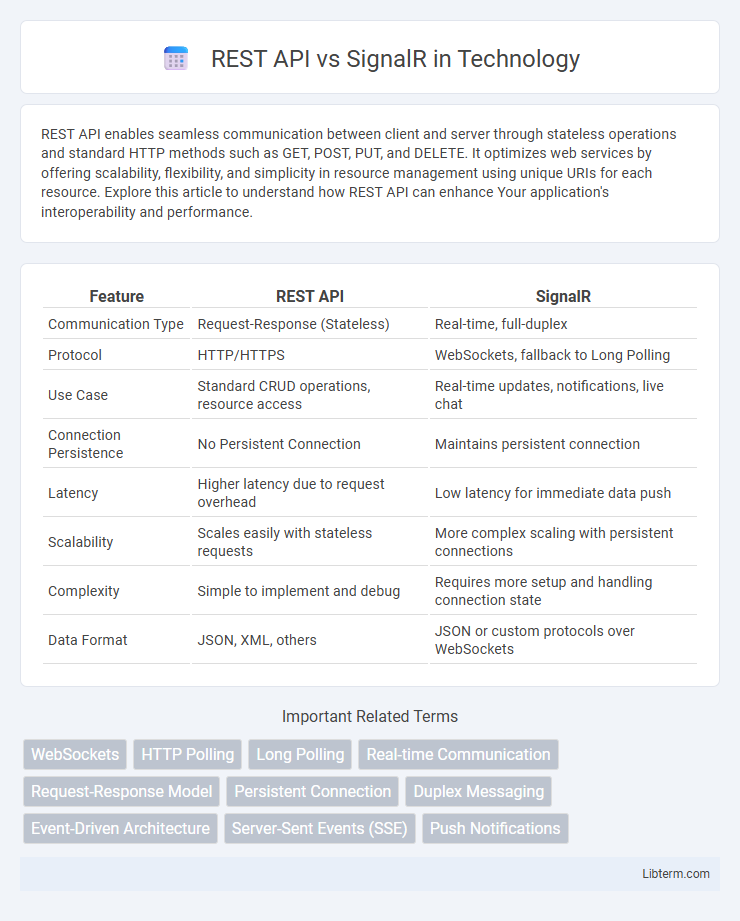REST API enables seamless communication between client and server through stateless operations and standard HTTP methods such as GET, POST, PUT, and DELETE. It optimizes web services by offering scalability, flexibility, and simplicity in resource management using unique URIs for each resource. Explore this article to understand how REST API can enhance Your application's interoperability and performance.
Table of Comparison
| Feature | REST API | SignalR |
|---|---|---|
| Communication Type | Request-Response (Stateless) | Real-time, full-duplex |
| Protocol | HTTP/HTTPS | WebSockets, fallback to Long Polling |
| Use Case | Standard CRUD operations, resource access | Real-time updates, notifications, live chat |
| Connection Persistence | No Persistent Connection | Maintains persistent connection |
| Latency | Higher latency due to request overhead | Low latency for immediate data push |
| Scalability | Scales easily with stateless requests | More complex scaling with persistent connections |
| Complexity | Simple to implement and debug | Requires more setup and handling connection state |
| Data Format | JSON, XML, others | JSON or custom protocols over WebSockets |
Introduction to REST API and SignalR
REST API is a stateless architectural style that enables communication between client and server via standard HTTP methods like GET, POST, PUT, and DELETE for resource manipulation. SignalR is a real-time communication library for ASP.NET that facilitates bidirectional communication between server and client, allowing instant data push through WebSockets or fallback technologies. REST APIs excel in standard CRUD operations and scalability, while SignalR is ideal for real-time features such as live chat, notifications, and gaming updates.
Core Concepts: REST API Explained
REST API relies on stateless communication using standard HTTP methods such as GET, POST, PUT, and DELETE to perform CRUD operations on resources represented by URIs. It emphasizes a client-server architecture with a uniform interface, allowing scalability and cacheable responses to improve performance. REST APIs typically follow a request-response model where clients initiate requests and servers provide responses without maintaining persistent connections.
Core Concepts: SignalR Explained
SignalR is a real-time communication library for ASP.NET that enables server code to push content to connected clients instantly, often used for chat applications, live dashboards, and gaming. Unlike REST API, which follows a request-response model using HTTP verbs, SignalR establishes persistent connections using WebSockets or fallback techniques to provide bidirectional communication. Core to SignalR is the concept of hubs, which manage connections, groups, and messaging, allowing efficient and scalable real-time client-server interaction.
Communication Patterns: Request-Response vs Real-Time
REST API follows a request-response communication pattern where clients send requests to the server and wait for responses, making it ideal for stateless operations and CRUD interactions. SignalR enables real-time communication by establishing persistent connections, allowing servers to push updates to clients instantly without explicit requests. This difference makes SignalR suitable for live chat, notifications, and dynamic data streaming scenarios where low latency and continuous data flow are critical.
Performance Comparison: REST API vs SignalR
SignalR provides real-time bi-directional communication, significantly outperforming REST APIs for scenarios requiring instant data updates and low latency, such as live chat or gaming applications. REST APIs rely on stateless HTTP requests, which induce overhead and latency due to repeated client-server polling, making them less efficient for frequent or continuous data transfer. For performance-critical applications demanding persistent connections and minimal delay, SignalR's use of WebSockets or fallback transports ensures faster and more efficient communication compared to traditional REST API calls.
Scalability Considerations
REST API scalability relies on statelessness, allowing easy horizontal scaling through load balancers distributing independent requests across multiple servers. SignalR, designed for real-time communication, faces challenges in scaling due to persistent connections and the need for backplane technologies like Redis or Azure SignalR Service to synchronize messages across servers. Efficient SignalR scaling depends on infrastructure capable of managing connection state and message distribution without compromising latency or throughput.
Use Cases and Application Scenarios
REST API is ideal for stateless, request-response communication in CRUD operations, such as accessing and updating resources in web applications, mobile apps, and microservices. SignalR excels in real-time scenarios requiring persistent connections and low latency, including live chat systems, gaming leaderboards, and instant notifications. Combining REST APIs with SignalR can optimize performance by handling standard data requests via REST and real-time updates via SignalR in complex, interactive applications.
Security Implications
REST API relies on stateless HTTP protocols, making it easier to secure through established methods like OAuth 2.0, HTTPS, and token-based authentication, minimizing attack surfaces. SignalR introduces persistent connections via WebSockets or long polling, which require rigorous security measures to prevent vulnerabilities such as Cross-Site WebSocket Hijacking and unauthorized access. Proper implementation of SSL/TLS encryption, authentication tokens, and origin checks are critical to safeguard real-time communication channels in SignalR environments.
Integration and Development Complexity
REST API integration relies on stateless HTTP protocols, allowing straightforward implementation with standard tools and broad client compatibility, which simplifies development and debugging. SignalR introduces real-time communication via persistent connections using WebSockets or fallback techniques, increasing integration complexity due to connection management and server resource considerations. Developers must balance REST's simplicity and scalability against SignalR's advanced real-time capabilities and their associated infrastructure challenges.
Choosing Between REST API and SignalR
Choosing between REST API and SignalR depends on the application's communication requirements; REST API is ideal for stateless, request-response interactions and CRUD operations, providing simplicity and scalability for standard web services. SignalR excels in real-time, bidirectional communication scenarios such as live chat, notifications, and gaming, offering persistent connections and automatic fallback across multiple transport protocols. Evaluating factors like latency sensitivity, connection persistence, and data synchronization needs helps determine the optimal choice between REST API's stateless architecture and SignalR's real-time capabilities.
REST API Infographic

 libterm.com
libterm.com